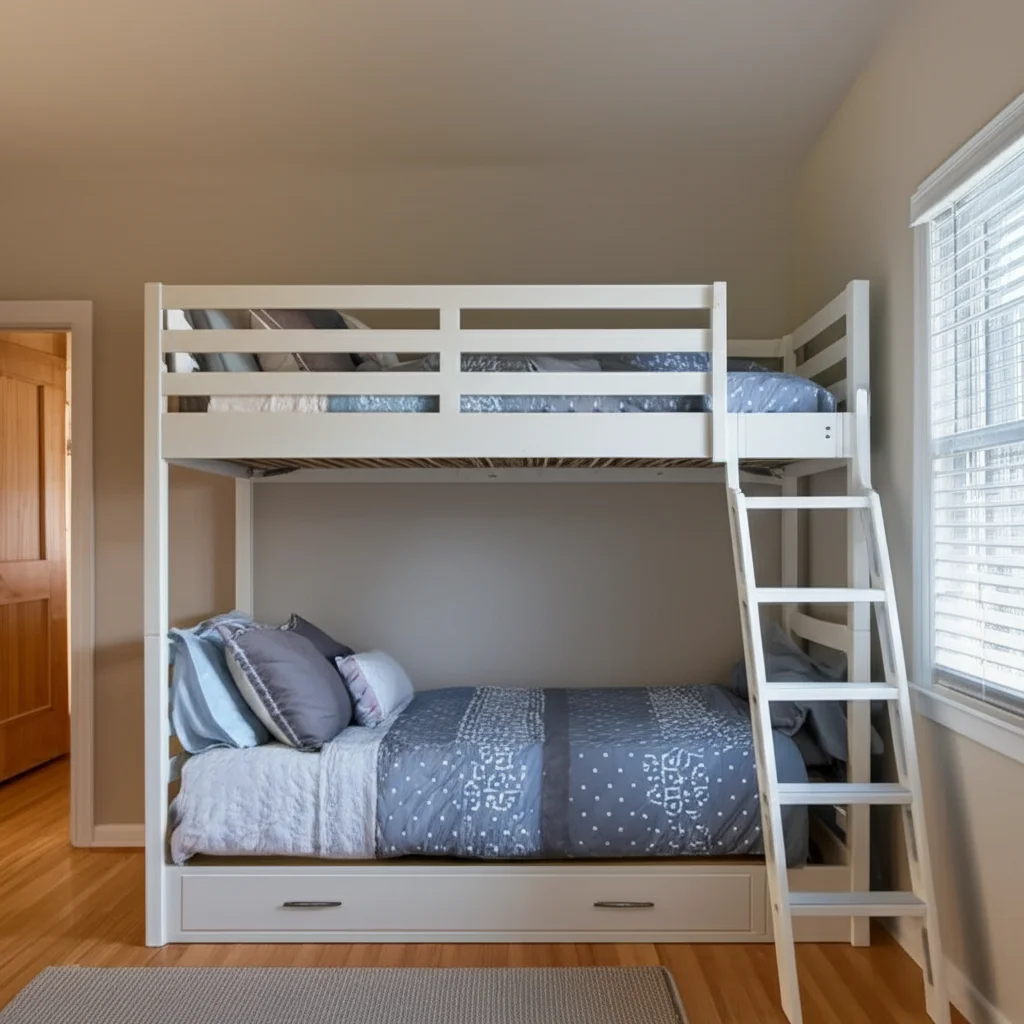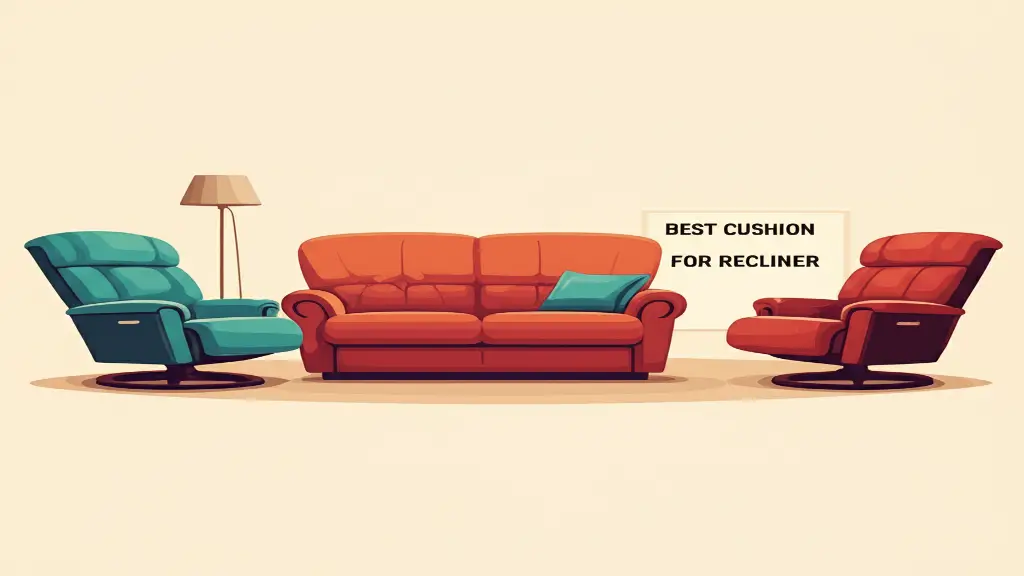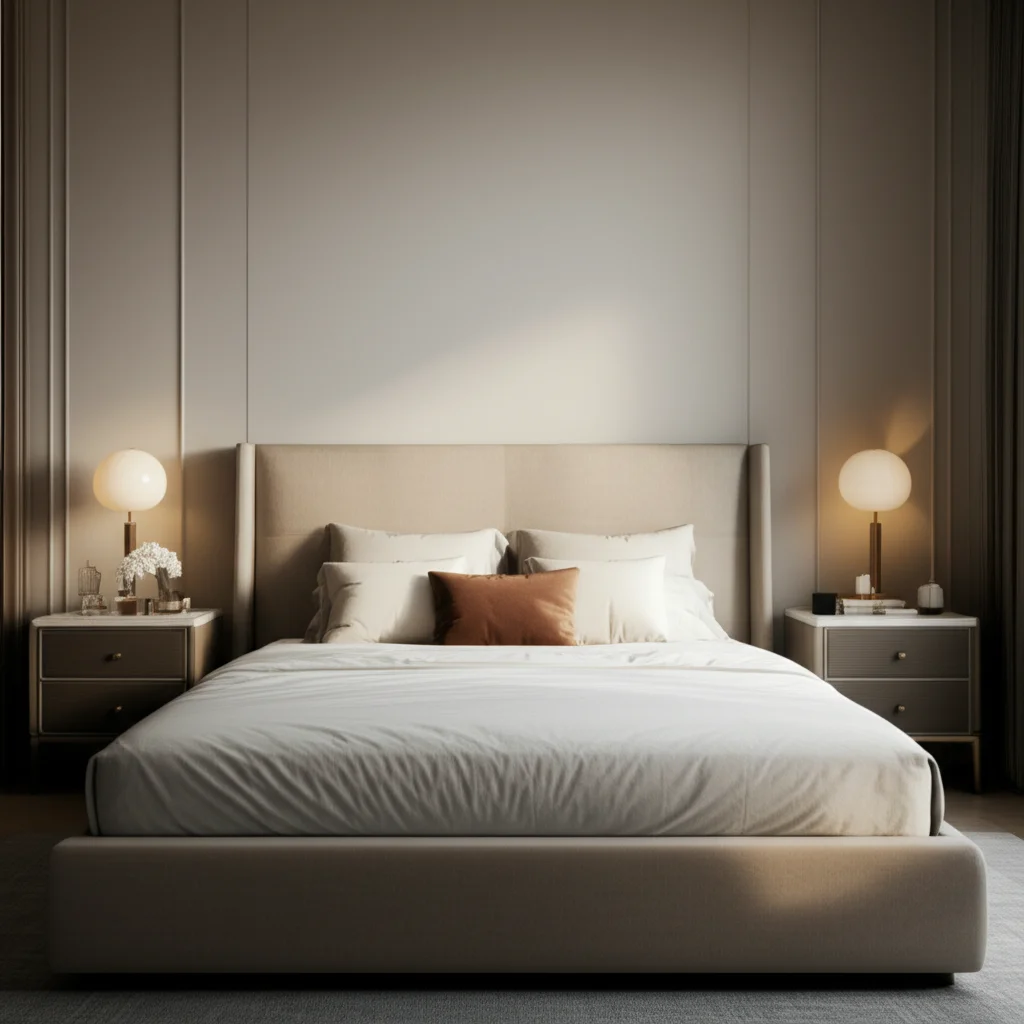· Katria Melrose · Home Comfort · 18 min read
How To Make Bunk Bed Ladder More Comfortable

Make Your Bunk Bed Ladder More Comfortable: A Comprehensive Guide
Do you dread climbing your bunk bed ladder? Many people do. The hard rungs can hurt bare feet. They can feel unstable or too narrow. A comfortable bunk bed ladder makes a big difference. It improves safety and daily convenience.
This guide explores practical ways to transform your bunk bed ladder. We will cover simple fixes like padding. We will also discuss structural improvements. You can make your ladder a joy to use. This article helps you create a more comfortable sleep space. It provides actionable steps for a better bunk bed experience.
Takeaway
To make your bunk bed ladder more comfortable:
- Add padding or wraps to the rungs.
- Improve grip with non-slip materials.
- Increase rung width or stability.
- Consider alternative climbing solutions.
- Ensure proper lighting around the ladder.
To make a bunk bed ladder more comfortable, apply soft padding to hard rungs, ensure proper spacing and width for feet, and enhance stability to reduce wobbling. Adding grip tape or wraps prevents slipping, creating a safer and more pleasant ascent or descent.
Understanding Common Ladder Discomfort
Bunk bed ladders often cause discomfort. Rungs are typically narrow and hard. This design can press uncomfortably into feet. Some ladders wobble when you climb them. This instability creates a feeling of insecurity.
Thin metal or wood rungs lack cushioning. They offer little support for weight. This leads to pain or bruising, especially for children. Cold materials can also be unpleasant to touch in cooler rooms. Addressing these common issues helps make the ladder comfortable.
Identifying the Problem Areas
Discomfort usually comes from specific ladder parts. The rungs are the main culprits. They are often too thin for foot support. Their hard material also contributes to pain. Sometimes, the ladder’s angle is too steep. This makes climbing more difficult.
The distance between rungs can be wrong. It can be too far apart for small children. It can be too close for adults. A loose ladder attachment also causes wobbling. Identifying these points helps you choose the best comfort solutions.
Impact on Daily Use
An uncomfortable ladder discourages use. Children may avoid their top bunk. Adults might find it frustrating. This reduces the bunk bed’s overall value. Safety also becomes a concern. People might rush or slip if the ladder hurts their feet.
Poor comfort can lead to minor injuries. It can also cause fear of falling. Making the ladder comfortable encourages proper use. It supports a peaceful sleeping environment. This improves the daily experience for anyone using the top bunk.
Enhancing Rung Comfort with Padding and Wraps
Adding padding is a quick way to improve ladder comfort. Soft materials cushion your feet. This reduces pressure and pain. You can choose from various padding options. Each option offers different benefits.
Padding also makes the ladder feel warmer. It provides a better grip. This makes climbing safer. This simple step can greatly improve your bunk bed experience. It turns a harsh climb into a gentle ascent.
DIY Padding Solutions
You can create padding using common materials. Foam pipe insulation is a good choice. It wraps easily around rungs. You can cut it to size and secure it. Old towels or fabric scraps also work well. You can wrap them around rungs and tape them.
Yoga mats are another option. Cut strips from an old mat. Then, attach them to the top of each rung. Use strong adhesive or zip ties to secure them. These DIY methods are cost-effective. They offer immediate comfort.
- Foam Pipe Insulation:
- Choose insulation with an inner diameter matching your rung thickness.
- Slit it lengthwise if it’s not already.
- Wrap around each rung, securing ends with strong tape or zip ties.
- This provides soft, continuous cushioning.
- Fabric Wraps:
- Cut strips of thick fabric, like fleece or old blankets.
- Wrap tightly around each rung, overlapping for extra padding.
- Sew or use fabric glue to hold the ends in place.
- Consider adding a layer of batting or thin foam inside for more cushion.
- Yoga Mat Strips:
- Cut strips about 2-3 inches wide from an old yoga mat.
- Glue these strips to the top surface of each rung.
- Ensure the adhesive is strong and dries completely before use.
- This adds a durable, non-slip padded surface.
Commercial Rung Covers and Wraps
Many commercial products exist for ladder comfort. These items are designed for easy installation. They offer a professional finish. Bunk bed ladder covers are available online. They often feature slip-resistant surfaces.
Some covers use dense foam. Others use gel inserts for cushioning. Consider products made from durable materials. They will withstand frequent use. Look for covers that fit your ladder’s rung size. This ensures a snug and secure fit.
- Custom-Fit Ladder Rung Covers:
- These are often made from durable plastic or rubber.
- They snap or slide over existing rungs.
- Many have textured surfaces for improved grip.
- Measure your rung dimensions carefully before purchasing.
- Neoprene or Fabric Wraps with Velcro:
- These wraps are easy to attach and remove.
- They offer soft cushioning and some insulation.
- Velcro closures ensure a snug fit.
- They are washable, which helps maintain hygiene.
- Non-Slip Stair Treads (Modified):
- While designed for stairs, smaller versions can be adapted.
- Cut to fit the top surface of the rungs.
- These provide excellent grip and some cushioning.
- Secure them firmly with strong adhesive or screws.
Improving Grip and Safety
A good grip is vital for ladder safety. Slippery rungs can cause falls. Improving grip also makes climbing feel more secure. This reduces anxiety during ascent and descent. Different materials offer various grip levels.
Combine grip solutions with padding for best results. This ensures both comfort and safety. A secure ladder encourages confident use. It makes the top bunk more accessible.
Adding Non-Slip Surfaces
You can apply non-slip tape to rungs. This tape has a textured surface. It provides friction for shoes or bare feet. Self-adhesive sandpaper strips also work. They offer excellent grip but can be abrasive.
Rubber mats or textured fabric can be glued to rungs. Ensure any adhesive used is strong. It must withstand regular foot traffic. These surfaces prevent slipping. They increase confidence when climbing.
- Anti-Slip Tape:
- Choose heavy-duty, outdoor-grade anti-slip tape.
- Clean each rung thoroughly before application.
- Apply strips across the top surface of each rung.
- Press firmly to ensure good adhesion.
- Rubber Strips or Mats:
- Cut thin rubber sheets into strips matching rung width.
- Attach using strong rubber adhesive or screws if rungs are wood.
- Textured rubber provides excellent wet or dry grip.
- Textured Spray Coatings:
- Specialty sprays create a non-slip texture.
- Mask off surrounding areas before applying.
- Follow product instructions for proper ventilation and drying times.
- This method offers a uniform, integrated look.
Ensuring Ladder Stability and Security
A wobbly ladder is never comfortable. It feels unsafe. Securely attach the ladder to the bunk bed frame. Check all bolts and screws. Tighten any loose connections. You can add extra brackets if needed. This improves the ladder’s overall stability.
Consider adding rubber feet to the ladder base. This prevents sliding on the floor. It also protects your flooring. A stable ladder provides peace of mind. It makes climbing a more confident experience. Ensuring the overall bed frame stability also contributes to the ladder’s feel. If your metal bed frame feels shaky, learning how to make a metal bed frame more stable can indirectly improve the ladder’s comfort by providing a solid base. Similarly, for loft beds, which share structural similarities with bunk beds, understanding how to make a loft bed hold more weight can give insights into reinforcing the entire structure.
- Regular Bolt Tightening:
- Periodically check all bolts and screws connecting the ladder to the bed.
- Use the correct tools to tighten them firmly.
- Do not overtighten, as this can damage wood or strip threads.
- Adding Bracing or Supports:
- For ladders that attach loosely, add L-brackets or corner braces.
- Secure these to both the ladder and the bed frame.
- Ensure they are strong enough to withstand weight and movement.
- Anti-Slip Feet or Grips:
- Attach rubber feet or furniture pads to the bottom of the ladder rails.
- These prevent the ladder from sliding on hard floors.
- They also reduce noise and protect flooring surfaces.
Optimizing Ladder Design and Ergonomics
Sometimes, more than padding is needed. The ladder’s design itself can be a problem. Optimizing its ergonomics improves comfort. This might involve modifying the existing ladder. It could also mean replacing it. Ergonomic improvements make climbing feel more natural.
Consider the user’s size and mobility. A ladder comfortable for a child may not suit an adult. Adjustments to rung spacing or width can make a big difference. These changes aim for a more comfortable and intuitive climb.
Widening Rungs for Better Foot Support
Narrow rungs dig into feet. Wider rungs distribute weight better. You can attach a piece of wood or strong plastic to existing rungs. This effectively creates a wider stepping surface. Ensure the added material is secure.
Use screws or strong adhesive for attachment. Test the new rungs for stability. This modification significantly reduces foot pain. It makes climbing feel more stable. It is a common DIY upgrade.
- Attach Wood Blocks:
- Cut wood pieces to your desired width.
- Drill pilot holes into the wood pieces and existing rungs.
- Secure the new, wider pieces to the top of each rung using screws.
- Ensure the screws are flush or countersunk to prevent injury.
- Use Plywood or MDF Panels:
- Cut rectangular panels slightly wider than existing rungs.
- Create a slot or cut-out on the underside of the panel to fit over the rung.
- Secure the panel in place with screws or strong construction adhesive.
- This creates a flat, wide step over the original rung.
Adjusting Rung Spacing or Angle
The distance between rungs impacts comfort. If the spacing is too wide, it’s a stretch. If too narrow, feet can trip. Adjusting rung spacing is difficult for pre-made ladders. A custom-built ladder offers this flexibility.
For existing ladders, you might add a half-step. This is a small platform between two rungs. It can break up large gaps. A shallower ladder angle also helps. This reduces the effort needed to climb. It puts less strain on legs.
- Consider a Custom Ladder:
- If current spacing is very problematic, a new ladder might be best.
- Design it with optimal rung spacing for the primary user.
- Ensure the angle is less steep for easier ascent.
- This is a significant project but offers the most ergonomic control.
- Adding Intermediate Steps (Advanced DIY):
- This involves attaching smaller, new rungs between existing ones.
- Requires careful measurement and secure attachment to the ladder rails.
- Ensure the added steps do not compromise the ladder’s integrity.
- This is most feasible for ladders with thick side rails.
Installing Handrails for Support
Handrails provide extra support. They give something stable to hold onto. This improves balance and security. Handrails are especially helpful for children. They also assist adults with less mobility.
You can attach handrails directly to the bunk bed frame. Ensure they are at a comfortable height. They should be strong enough to bear weight. Handrails make climbing feel much safer. They reduce the reliance on foot grip alone.
- Wall-Mounted Handrails:
- Install a small, sturdy handrail on the wall next to the ladder.
- Ensure it is anchored into wall studs for maximum stability.
- Position it at a height comfortable for the user to grasp.
- Bed Frame Integrated Handrails:
- If your bunk bed allows, attach vertical rails to the bed frame near the ladder.
- These can extend from the bottom to the top bunk level.
- Ensure they are securely bolted to the bed structure.
- Ladder-Mounted Handrails:
- Some ladders allow for direct attachment of short, auxiliary handrails.
- These are usually smaller and provide immediate grip points.
- Check if your ladder’s design supports such an addition safely.
Exploring Alternative Climbing Solutions
Sometimes, a traditional ladder is not the best fit. Alternative climbing methods offer more comfort. They can also add storage or fun to the room. These options often provide wider steps. They can be easier to navigate.
Consider a ramp or stair system. These provide a gentle incline. They reduce the need for vertical climbing. These alternatives are a good investment. They enhance the overall safety and functionality of your bunk bed.
Step Ladders or Staircases
A small set of stairs can replace a ladder. Stairs offer a much wider stepping surface. They provide more stability. Each step can also include storage drawers. This adds functionality to your bunk bed area.
Building or buying a bunk bed staircase is a larger project. However, it offers superior comfort and safety. It creates a more permanent and robust climbing solution. This is ideal for long-term use.
- Prefabricated Stair Units:
- Many bunk bed manufacturers offer matching stair units.
- These often include integrated drawers for storage.
- Measure your bed carefully to ensure compatibility.
- Custom-Built Staircases:
- If pre-made options do not fit, build a custom staircase.
- This allows for precise sizing and design.
- It offers the most opportunity for personal comfort features.
- Portable Step Stool (for lower bunks):
- For younger children or lower bunk heights, a sturdy step stool can assist.
- Choose one with a wide base and non-slip surface.
- This is a temporary solution for occasional use.
Climbing Walls or Rock Climbing Holds
For a more adventurous approach, consider a climbing wall. Small, child-friendly rock climbing holds can be attached to a sturdy panel. This panel then attaches to the bunk bed frame. This option offers a fun, engaging way to reach the top bunk.
It also provides excellent grip. This requires careful installation and safety considerations. Ensure the panel and holds can support the user’s weight. This creative solution adds excitement and comfort.
- Install a Plywood Panel:
- Secure a thick plywood panel to the side of the bunk bed frame.
- Ensure the panel is adequately braced and stable.
- Choose wood thick enough to hold climbing bolts.
- Attach Climbing Holds:
- Purchase child-friendly climbing holds with varying textures and sizes.
- Bolt them securely through the plywood panel.
- Space them appropriately for comfortable climbing, considering arm and leg reach.
- Ensure Safety:
- Always use crash pads or thick mats below the climbing wall.
- Supervise children, especially when they are new to using it.
- Regularly check holds and bolts for tightness.
Ramps with Non-Slip Surfaces
A ramp provides the gentlest incline. It eliminates the need for lifting feet. This is ideal for young children or those with mobility challenges. The ramp surface must be non-slip. Use carpet or textured rubber.
A bunk bed ramp requires space. It extends outwards from the bed. This is a custom solution. It offers unmatched ease of access. It makes the top bunk fully accessible to almost anyone.
- Custom-Built Ramp:
- Design a ramp with a gentle slope.
- Build a sturdy wooden frame for the ramp.
- Ensure the ramp’s top edge connects securely to the bunk bed.
- Non-Slip Surfacing:
- Cover the ramp surface with carpet, rubber matting, or non-slip paint.
- This prevents slipping during ascent and descent.
- Ensure the surface is easy to clean.
- Safety Rails:
- Add handrails along both sides of the ramp.
- This provides additional support and prevents falls.
- Ensure rails are at an appropriate height for users.
Maintaining Your Ladder for Lasting Comfort
Comfort is not just about initial fixes. Regular maintenance keeps your ladder comfortable. It ensures long-term safety. A well-maintained ladder performs better. It also extends its lifespan.
Simple checks and cleaning routines are key. Address any issues promptly. This prevents small problems from becoming big ones. Your efforts will ensure your bunk bed ladder remains a comfortable pathway.
Regular Inspections and Tightening
Periodically inspect your bunk bed ladder. Look for loose screws or bolts. Check for cracks in wood or bends in metal. Tighten any fasteners you find loose. This maintains structural integrity.
A stable ladder is a comfortable ladder. Loose parts can cause wobbling. They can also create pinching hazards. Regular checks prevent discomfort. They also keep the ladder safe for all users.
- Weekly Visual Check:
- Quickly scan the ladder for any visible damage.
- Look for splintered wood, bent metal, or missing parts.
- Ensure all rungs appear secure in their attachments.
- Monthly Fastener Check:
- Use a screwdriver or wrench to test all bolts and screws.
- Tighten any that feel loose, but avoid overtightening.
- Check both ladder-to-bed connections and rung-to-rail connections.
- Listen for Noises:
- Pay attention to creaks or groans when the ladder is used.
- These noises often signal loose connections or structural stress.
- Investigate the source of the noise promptly.
Cleaning and Hygiene of Ladder Additions
Padding and wraps can collect dirt. They can also accumulate sweat. Regular cleaning is important for hygiene. It also helps maintain their appearance. Dirty padding can become unappealing.
Follow cleaning instructions for your chosen materials. Fabric covers might be machine washable. Foam padding can be wiped clean. Keeping additions clean ensures a pleasant experience. It also prevents the spread of germs.
- Vacuum or Brush:
- Use a handheld vacuum or a stiff brush to remove dust and debris.
- Do this weekly or as needed, especially in high-traffic areas.
- Spot Clean:
- For small stains, use a mild soap and damp cloth.
- Blot the area gently; avoid saturating fabric padding.
- Allow to air dry completely before use.
- Deep Clean (if applicable):
- If covers are removable and washable, follow care instructions.
- For fixed padding, use a fabric cleaner or upholstery shampoo.
- Ensure proper ventilation during and after cleaning.
Replacing Worn-Out Components
Padding and grip tape wear down over time. They lose their effectiveness. Worn-out components compromise comfort. They also reduce safety. Replace them as soon as you notice significant wear.
Keep spare materials if possible. This makes replacements quick and easy. Timely replacement ensures consistent comfort. It maintains the ladder’s optimal performance. Your ladder will always feel safe and pleasant to use.
- Monitor Wear and Tear:
- Regularly check padding for flattening, tears, or fraying.
- Inspect grip tape for peeling edges or diminished texture.
- Examine any added steps or handrails for looseness or damage.
- Proactive Replacement:
- Do not wait until a component completely fails.
- Replace worn items before they become uncomfortable or unsafe.
- Keeping extra materials on hand can make this process faster.
- Consider Upgrades:
- When replacing components, evaluate if a better material is available.
- Perhaps more durable padding or stronger grip tape exists.
- This is an opportunity to further improve comfort and longevity.
Lighting and Accessibility Considerations
Comfort goes beyond the ladder itself. The surrounding environment matters. Good lighting improves visibility. This makes climbing safer and more confident. It also reduces the chance of missteps.
Accessibility enhancements ensure anyone can use the bunk bed. This includes adding specific features for different needs. Thinking about these aspects creates a truly comfortable and user-friendly space.
Ensuring Proper Lighting Around the Ladder
Climbing in the dark is risky. Install a nightlight near the ladder. A small LED strip light can illuminate the rungs. Motion-activated lights are also a good idea. They turn on only when needed.
Ensure the light is not too bright. It should provide enough visibility without disturbing sleep. Good lighting prevents falls. It makes nighttime trips to the bathroom much safer.
- Plug-In Night Lights:
- Place a low-wattage night light in an outlet near the ladder base.
- Choose one with a light sensor that turns on automatically in darkness.
- LED Strip Lighting:
- Adhere a thin LED strip along the side of the ladder rails.
- Connect it to a small battery pack or a USB power source.
- Opt for warm white light for a softer glow.
- Motion-Activated Lights:
- Install a small battery-operated, motion-sensing light near the ladder.
- It will activate automatically when someone approaches.
- This saves energy and provides light only when needed.
Adding Assistive Devices for Easier Climbing
Some users might benefit from extra help. A sturdy step stool at the base can bridge a gap. A grab bar mounted to the wall can provide balance. These devices assist those with limited mobility.
They also help younger children. Assess the user’s specific needs. Choose devices that offer the most support. These additions enhance safety and independence. They make the bunk bed accessible to more people.
- Bedside Step Stool:
- Place a stable, non-slip step stool at the bottom of the ladder.
- This reduces the first step height, making it easier to start the climb.
- Ensure it is heavy enough not to tip.
- Wall-Mounted Grab Bar:
- Install a secure grab bar on the wall next to the ladder.
- Position it at a comfortable height for the user to hold onto.
- Ensure it is anchored into wall studs.
- Adjustable Bed Height (if applicable):
- While not ladder-specific, sometimes adjusting overall bed height can help.
- If your bunk bed allows, lowering the entire structure slightly can shorten the climb.
- This is a less common feature but worth considering if available.
Personalizing Your Ladder for Unique Needs
Every user is different. Personalizing the ladder addresses specific needs. It tailors the comfort solutions. This ensures maximum satisfaction. Consider the age and physical abilities of the user.
A child might prefer colorful padding. An adult might need robust handrails. Customization makes the ladder truly comfortable. It transforms it into a custom fit. This enhances the overall experience.
Customizing for Children vs. Adults
Children benefit from bright colors and soft textures. Non-slip surfaces are crucial for their small feet. Adults may prioritize durability and ergonomic support. Wider rungs and sturdy handrails are often preferred.
Think about leg length and reach. These factors influence rung spacing and handrail placement. Tailoring solutions ensures optimal comfort for the primary user. It makes the ladder truly effective for them.
- For Children:
- Use colorful padding or themed wraps to make climbing fun.
- Ensure rung spacing is appropriate for shorter legs.
- Add highly visible anti-slip surfaces.
- Consider glow-in-the-dark elements for nighttime visibility.
- For Adults:
- Focus on durable, dense padding for heavier weight.
- Prioritize strong, well-placed handrails for stability.
- Ensure rung width and spacing accommodate adult foot size.
- Opt for more subtle or neutral colors for a mature look.
Incorporating Storage or Decorative Elements
The ladder can be more than just a climbing tool. Incorporate small storage solutions. Hang a mesh pocket for a phone or book. Add a small shelf at the top for water bottles. This adds convenience.
Decorate the ladder to match the room. Paint it a fun color. Add decorative decals to the rungs. This makes the ladder an integrated part of the room’s design. It enhances its appeal and perceived comfort. For those interested in DIY projects, exploring how to make a drawer out of wood or how to make a wood bench with back could inspire custom storage steps or seating near the bunk bed, adding both utility and comfort.





